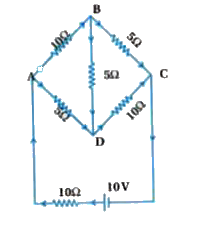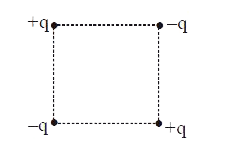A particle having mass 1 g and electric charge 10−8C travels from a point A having electric potential 600 V to the point B having zero potential. What would be the change in its kinetic energy ?Solution in Gujrati
−6×10−6 erg
−6×10−6J
6×10−6 J
6×10−6 erg
The correct Answer is:A
From the definition of electric potential, work done by electric field in moving a unit positive charge from point A to B = W = 600 J
∴ Work done in moving 10−8 C charge from point A to B =600×10−8=6×10−6J
According to work energy theorem ,
W=Δ∴W=ΔK=6×10−6 J
Topper's Solved these Questions
- ELECTROSTATIC POTENTIAL AND CAPACITANCEBOOK - KUMAR PRAKASHANCHAPTER - ELECTROSTATIC POTENTIAL AND CAPACITANCEEXERCISE - Section D ( MCQs asked in Cometitive Exams )
39 Videos
- ELECTROSTATIC POTENTIAL AND CAPACITANCEBOOK - KUMAR PRAKASHANCHAPTER - ELECTROSTATIC POTENTIAL AND CAPACITANCEEXERCISE - Section C ( NCERT Exemplar Solution ) ( Long Answer Type Questions )
12 Videos
- ELECTROMAGNETIC WAVESBOOK - KUMAR PRAKASHANCHAPTER - ELECTROMAGNETIC WAVESEXERCISE - BOARD.S QUESTION PAPER MARCH - 2020 (PART - B) SECTION - C
5 Videos
- MAGNETISM AND MATTERBOOK - KUMAR PRAKASHANCHAPTER - MAGNETISM AND MATTEREXERCISE - SECTION D Multiple Choice Questions (MCQs) (MCQs asked in Competitive Exams) MCQs asked in Board Exam and GUJCET
7 Videos
Similar Questions
Capacitance of a capacitor 100 μ F. The work is done for depositing chargc 8×10−18 C on it will be .........
View SolutionFind the equation of the equipotential for an infinite cylinder of radius r0 carrying charge of linear density λ.
View SolutionDetermine the current in each branch of the given network.

View SolutionAt a place on earth the vertical component of earth's magnetic field is √3 times its horizontal component. The angle of dip at this place is …...
View SolutionAn alpha particle is placed in an electric field at a point having electric potential 5V. Find its potential energy ?
View SolutionA ball of mass 1 kg carrying a charge 10−8C moves from a point A at potential 600 V to a point B at zero potential. The change in its kinetic energy is
View SolutionFind the change in electric potential energy , Delta U as a charge of (a) 2.20 xx 10^(-6) C. (b) - 1.10 xx 10^(-6) C moves from a point A to a point given that the change in electric potential between these points is DeltaV= V_(B) -V_(A) = 24.0 V
View Solution4.3×10−6C तथा −2×10−8C के दो आवेश परस्पर 15cm दूर है। इन दोनों आवेशों को मिलाने वाली रेखा के किस बिन्दु पर विद्युत विभव शून्य होगा? अनन्त पर विद्युत विभव शून्य मान लो।
View SolutionA particle of charge 1 muC is moving from point A that is at potential 100 V to point B that is at potential 500 V. Calculate the change in kinetic energy of the charged particle.
View SolutionAt some distance from a charge, the potential is 600 V and the electric field is 200 N / C. (a) How far is the point charge? (b) What is the magnitude of charge?
View SolutionThe electric potential at point A is 1V and at another point B is 5V. A charge 3μC is released from B. What will be the kinetic energy of the charge as it passes through A?
View Solution1gm द्रव्यमान तथा 10−8C आवेश की एक गेंद को बिन्दु A जिस पर 600 V विभव है से बिन्दु B जिस पर विभव शून्य है तक ले जाया जाता है | बिन्दु B पर गेंद का वेग 20 सेमी./सैकण्ड है | बिन्दु A पर गेंद का वेग होगा
View Solutionकथन-1: कोनो पर चित्रानुसार बिन्दु आवेश वाले वर्ग के केन्द्र पर विद्युत विभव एवं विद्युत क्षेत्र की तीव्रता शून्य होगी।

कथन-2: यदि किसी बिन्दु पर विद्युत विभव शून्य हो तो उस बिन्दु पर विद्युत विभव निश्चित रूप से शून्य होगा।
View SolutionFind the change in electric potential energy , ΔU as a charge of (a) 2.20×10−6C. (b) −1.10×10−6C moves from a point A to a point given that the change in electric potential between these points is ΔV=VB−VA=24.0V
View SolutionAn alpha particle is placed in an electric field at a point having electric potential 5V. Find its potential energy ?
View Solution
